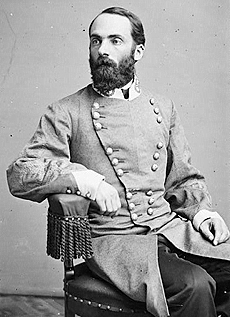Marking the mystic chords
of memory
By Wesley Pruden
PrudenPolitics.com
The crowds came over the weekend to visit Arlington
National Cemetery, the resting place of the nation’s
heroes and the national refuge of broken hearts.
The long line of holiday visitors moved reverently
down the lanes through rows of white marble
headstones, with only the low chatter of
conversation breaking the stillness on the hill
where Robert E. Lee’s mansion gave the graveyard its
name.
Most of the markers are carved with only modest
biography: names, dates, ranks and names of the
states from whence men answered their country’s call
to arms. Memorial Day is still observed at Arlington
as it was meant to be observed.

Gen. Joe Wheeler is one of the few senior
Confederate officers allowed to sleep in a grave at
Arlington.
Like all our national summer holidays, the day is
observed mostly with picnics, the occasional burst
of fireworks creasing the night sky, raucous noise
billed as music and the swilling of enormous
quantities of brewed beverages. Memorial Day is
different, if only by degree. But its origins are
lost in argument, its original purpose shrouded in
the fog of forgetfulness. Several cities in both
North and South claim to be the holiday’s
birthplace, but the ceremonies and parades that once
made it a holiday second only to the Fourth of July
have been relegated to the dustbin of memory.
President Lyndon Johnson four decades ago declared
Waterloo, N.Y., to be the official birthplace of
Decoration Day (as it was first called) but the
women of the South decorated the graves of their
fallen sons even before the Civil War ended,
commemorated in a hymn, “Kneel Where Our Loves Lie
Sleeping,” published in 1867. Memorial Day was first
“officially” declared the following year by Gen.
John A. Logan, commander of the Grand Army of the
Republic—not an army at all, but a forerunner of the
American Legion—who rode across the Potomac on May
30 of that year to decorate the graves of both Union
and Confederate dead. His decoration of Southern
graves was not widely appreciated by the Radical
Republicans who presided over the capital that time
of bitter division.
The most persuasive claim for the origin of a
decoration day is made by Columbus, Ga., where the
widow of Col. C.J. Williams of the 1st Georgia
Infantry tended his grave with their little
daughter, after he died in the early days of the
Civil War. She visited his grave every day, to sit
in reflection of “the mystic chords of memory” while
their little girl plucked weeds from unmarked graves
nearby and covered them with flowers. She called
them the graves of “my soldier boys.” A short time
later, as a contemporary account told it, “the dear
little girl was summoned by the angels to join her
father,” and the widow, now childless, took up the
little girl’s practice of caring for soldiers’
graves. In March 1868, about the time that Gen.
Logan was first thinking of visiting Arlington with
his flowers, the Widow Williams suggested setting
apart one day every year as the occasion for “love
to pay tribute to valor.” She suggested April 26,
and to this day in hundreds of graveyards across the
South women pay separate tribute to Southern valor
by placing tiny Confederate battle flags at the foot
of the graves of their honored dead.
From the beginning, the tribute to the memory of
sacrifice was an attempt to bridge the partisan
divide. Politicians in both North and South were
eager to wave the bloody shirt come election time,
and it was the women who were, as usual, the
civilizing influence. But civilizing men, as most
any woman is eager to tell you, is not always easy.
The echoes of shot and shell that had summoned men
to battle were barely beginning to fade when America
stood at the cusp of war with Spain just as the
century ended. Not everyone though it was a good
idea to organize Southerners into an army so soon
after Appomattox. Someone had the good idea of
offering command to a former Confederate officer,
and to Gen. Joe Wheeler, a hard-hitting cavalry
commander from Alabama who briefly delayed Sherman’s
torching of Atlanta. He and his troops fought well
in Cuba, though in the din of battle at Las Guasimas
he forgot where he was and rallied his men with the
cry: “Let’s go, boys! We’ve got the damn Yankees on
the run again.”
He died with his boots on in Brooklyn a decade
later, pleased to parade in his uniform of Union
blue, and he is one of the few senior Confederate
officers allowed to sleep in a grave at Arlington.
The flags of the two American nations whose uniforms
he wore decorated his grave this year.

